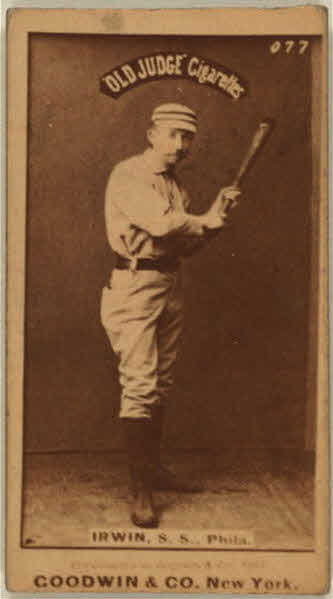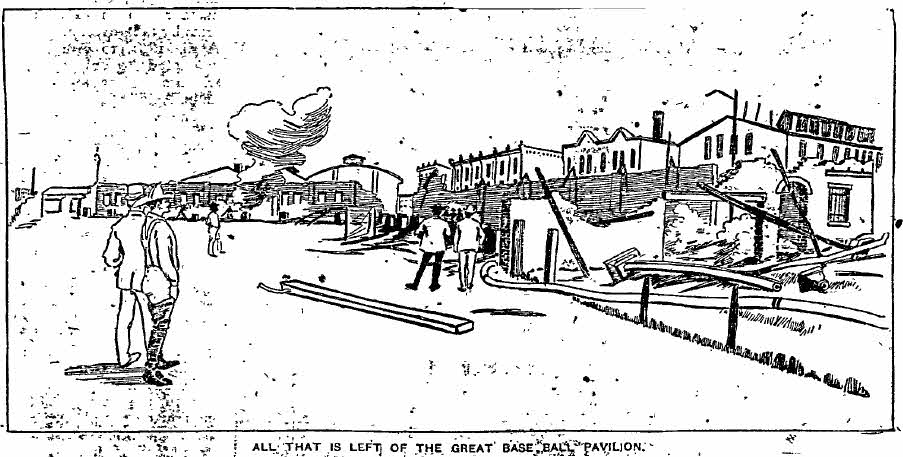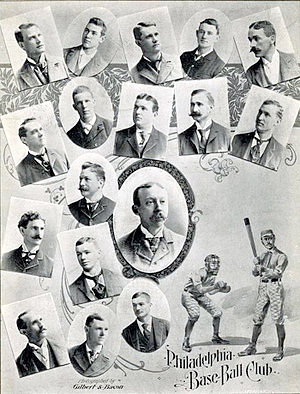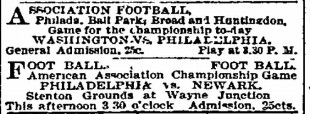With the start of the new Philadelphia Phillies season and the recent debut of the Philadelphia Union, it’s worth remembering that the history of soccer in Philadelphia has long connections to baseball. Walter Bahr, perhaps the greatest soccer player to come from the city, recently said, “In my neighborhood, Kensington, only two sports were played, baseball and soccer, and baseball was for the summer.”

Arthur Irwin found fame as a shortstop with the Philadelphia Phillies, the Washington Nationals and the Boston Reds before becoming a manager.
Many of the city’s earliest soccer clubs played their matches at now long gone baseball grounds around the city. To mention just a few of the more historic parks, Jefferson Park (North 25th and Jefferson Streets and once the home of the Athletics and also known as the Athletic Base Ball Grounds), the Philadelphia Base Ball Park (Broad Street and Huntingdon Avenue, once home to the Phillies and later renamed the Baker Bowl) and Forepaugh Park (Broad and Dauphin Streets and once the home of the Athletics and the Quakers) were all sites of important matches in the early days of soccer in Philadelphia. The owners of these grounds were happy for the chance to make money in the off-season and early soccer clubs benefited from playing at established venues.
One of those important early matches was an inter-city meeting between an All-Philadelphia team and the Cosmopolitans of New York on February 22, 1894. Reports at the time say the match drew 1500 spectators. Among those in the crowd was Arthur Irwin, manager of the Philadelphia Phillies. Two days after the match (which ended in a 3-3 draw), Irwin, described in the Philadelphia Inquirer as “a warm admirer of association football,” announced a “scheme” to have “a league of association football clubs composed of professional base ball men, and to have Brooklyn, New York, Washington, Baltimore, Boston and Philadelphia as the six cities in the circuit,” with games to be played in the winter to “enable the ball players to keep in good condition for their season’s work.” Irwin planned to bring up his “scheme” at an upcoming meeting of “baseball magnates” in New York.
When the two teams met again on March 24, 1894 in a match won by Philadelphia 4-0, Irwin was again in the crowd of some 2000 spectators. With him were the English-born Harry Wright, former manager of the Philadelphia Phillies and a future Hall of Famer, and two Phillies players, Charlie Reilly and future Hall of Famer Ed Delahanty.
Irwin’s “scheme” for a professional football league came to fruition on June 19, 1894 with the announcement of the formation of the American League of Professional Football Clubs, with Irwin as temporary president of the league. The Inquirer reported,
“The object of the league is to play football games in each of the represented cities from October 1 until January 1. Each city will be represented by the strongest players that can be secured. Home talent will be given the preference. The American Association Football rules of ’94 will govern all contests . . . The Philadelphia Club has already engaged seven players.”
The first professional soccer league in America had been formed and the Philadelphia Phillies were at the start of it.
A meeting in New York on August 14 formalized the establishment of the league under the name of the American League of Professional Football Players (ALPF) and adopted a constitution “built on the same lines as that of the National Base Ball League, but not . . . so bulky” with Irwin the elected president.
As Steve Holroyd describes, the ALPF owners “were anxious to impose the same monopolistic conditions” they enjoyed in baseball. With the retention of the “reserve clause” in ALPF player contracts—which would remain in effect in baseball until the advent of free agency in 1976— players were potentially “little more than chattel to the owners,” (a point recently made by the MLS Players Union during CBA negotiations with the MLS).
While Irwin had said in February that the purpose of the league was to keep baseball players “in good condition” it is obvious that the main purpose was to make money by using otherwise empty baseball stadiums in the off-season. Irwin may have had a further incentive to make some extra money for the Phillies: on August 6, the Philadelphia Base Ball Park, the Phillies’ home park, burnt almost entirely to the ground. Only the exterior outfield wall remained intact and for the rest of the baseball season spectators were seated in temporary stands.

Illustration from the front page of the August 7, 1894 edition of the Philadelphia Inquirer showing the aftermath of the Philadelphia Base Ball Park fire.
Still, as David Goldblatt notes in The Ball is Round: A Global History of Football, “the commitment and seriousness of the baseball franchises was questionable:” most games were scheduled on weekdays rather than on the weekend, when most of the potential working class audience would have been able to attend.
The insistence that each team play with the same name as its baseball counterpart, the hiring of baseball team managers to coach the soccer franchise, and stories which suggested that favorite baseball players would play on the soccer teams further reveal that the clubs were primarily interested in promoting their baseball teams in the off season, had doubts about soccer’s potential as a profitable draw in itself, or both. Interestingly, in England some professional soccer clubs were attempting to introduce baseball. As reported in The April 21 1894 edition of Harper’s Weekly, the idea was “to enable club-managers to come out nearer even, pecuniarily speaking, by keeping their players remunerative in summer, after the football season is over and ‘gates’ are of the past.”
The ALPF was greeted with suspicion in soccer circles and the American Football Association went so far as Clement Beecroft, who had helped to found Philadelphia’s first organized amateur league, in 1889. Made up of players who had been part of earlier all-Philadelphia teams, the Philadelphia Inquirer reported that this team played the “first professional game of association football . . . in this city” on September 29, 1894 at the Tioga Athletic grounds, defeating Trenton 11–1 in front of about a thousand spectators.



Comments